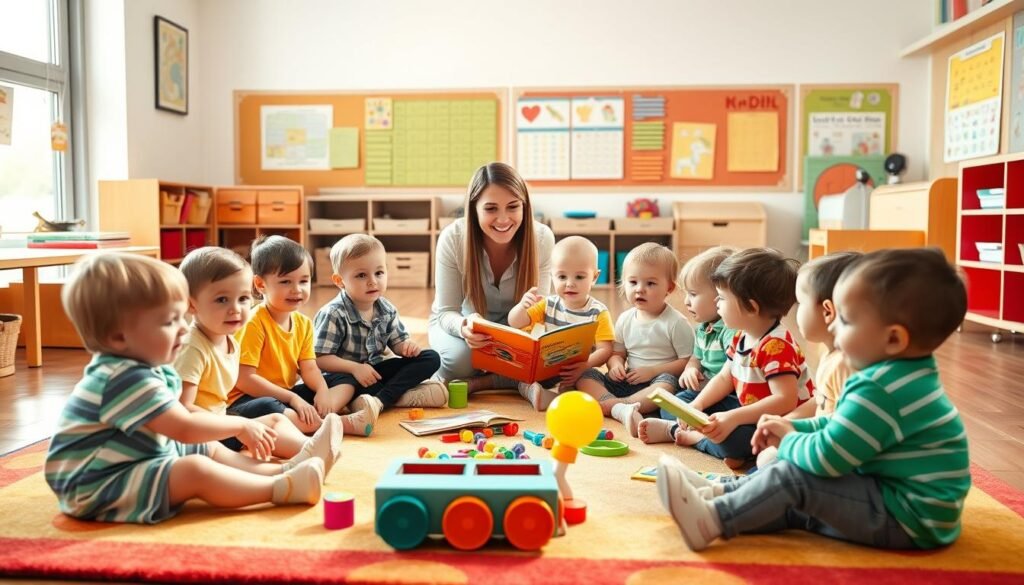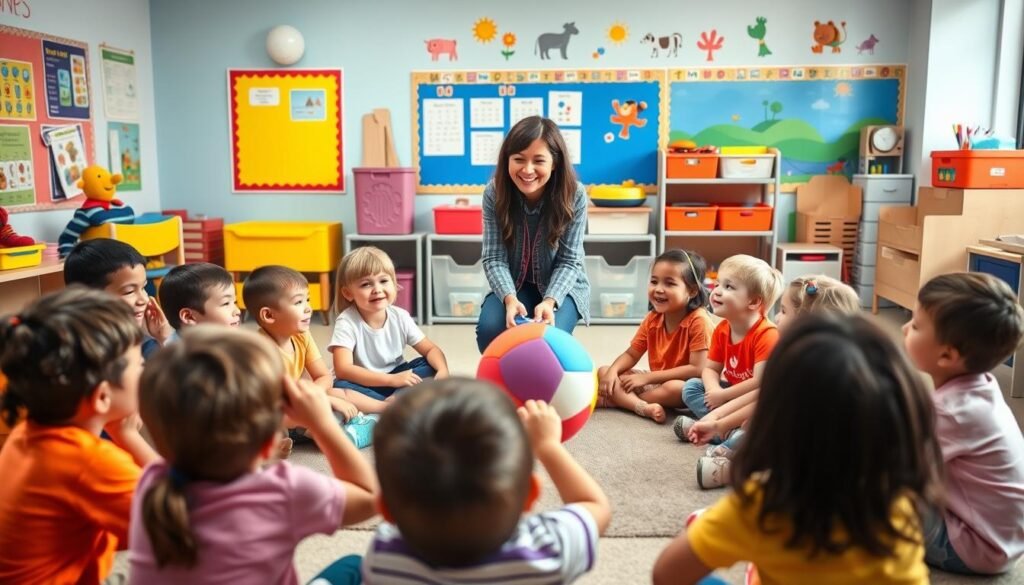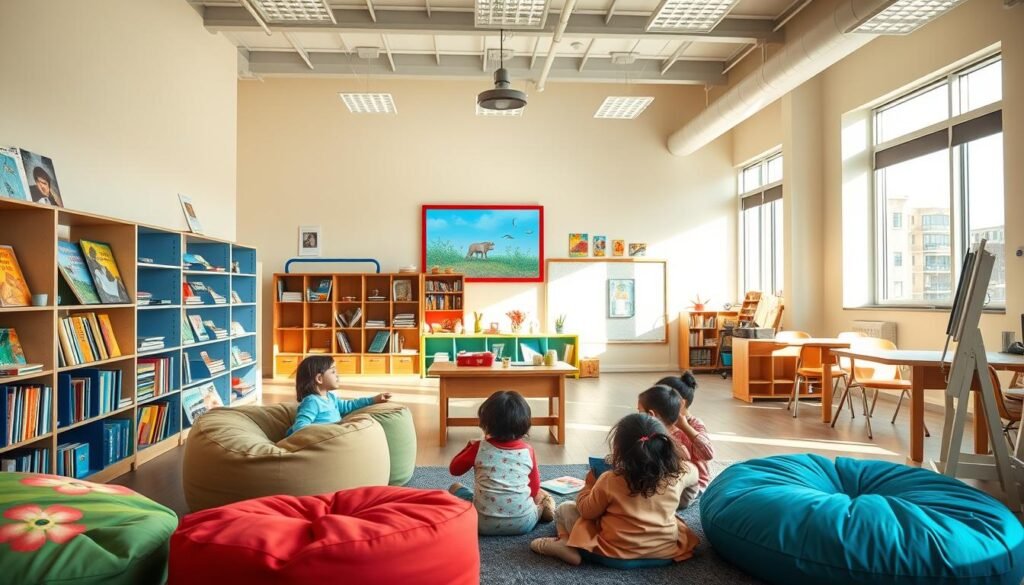
Starting school is a big adventure for young learners. The first day of kindergarten is filled with excitement and nerves for kids and teachers. A welcoming environment makes the transition smoother, making it a positive and memorable experience.
Kindergarten is more than just learning. It’s a time for building social skills, gaining confidence, and making memories. Knowing how kids feel on this day helps parents and teachers support them through this big change.
Good first-day activities help kids connect, establish routines, and feel safe. By planning fun and engaging experiences, you can turn anxiety into excitement for school.
Table of Contents
Setting Up Your Classroom for Success
Getting your kindergarten classroom ready is key. It should be welcoming and useful for learning. The right classroom setup helps young students start their educational journey.
Choosing a simple classroom design can make a big difference. Studies show that tidy classrooms can cut down on waiting time by 25%. They also make students more interested in learning.
Creating a Minimalist Learning Environment
For your kindergarten classroom, aim for simplicity and usefulness. Flexible seating can change how students learn. Research shows:
- 70% of teachers see better focus in their students
- Different areas for learning boost interest by up to 30%
- Custom spaces make students happier by 15%
Essential First-Day Materials and Supplies
Stock up your classroom with important items for kindergarten readiness:
- Individual name tags
- Color-coded supply crates
- Welcome packets for parents
- Basic learning center resources
Visual Aids and Labels for Navigation
Clear labels are a big help in early learning. They help students feel more confident and independent. Good classroom organization can save teachers about 30% of their time looking for things.
A well-designed classroom is more than just a room – it’s a gateway to learning and discovery.
Building a Welcoming Morning Routine
Creating a predictable kindergarten routine is key to reducing anxiety and making young learners feel safe. Your morning routine sets the day’s tone, making it vital to start with a welcoming and structured approach.
Start by making a consistent arrival process that helps kids smoothly transition. A warm welcome and clear expectations can turn stressful moments into positive ones.
- Play the “Backpack Boogie” song as students enter
- Encourage quick and organized backpack storage
- Use a “Helper of the Day” to assist with morning tasks
- Sing transition songs to guide classroom activities
Your morning routine should include fun activities that grab kids’ attention and ease separation anxiety. Interactive songs and movement can make students feel comfortable and eager to learn. Try quick, fun transitions like the “Criss Cross Applesauce” chant or counting games to help kids settle into their learning space.
Consistent morning routines can reduce classroom disruptions by up to 30% and improve students’ emotional security.
For a successful kindergarten morning, focus on a predictable sequence of activities, musical cues, and gentle guidance. By starting these routines early, you’ll help children feel confident and excited for their school day.
Teaching Essential Classroom Procedures
Kindergarten is all about learning important classroom rules. These rules help create a safe and structured place for learning. Your first day will be filled with key rules and guidelines.
Clear procedures are key to keeping the classroom orderly. Young students need clear instructions to feel safe and understand what’s expected of them.
Bathroom and Water Fountain Etiquette
Teaching bathroom and water fountain rules is important. It helps avoid accidents and keeps everyone clean. Your kindergarten tips should include:
- Always ask permission before leaving the classroom
- Use hand sanitizer after bathroom visits
- Practice proper handwashing techniques
- Wait in line quietly and respectfully
Lunchroom and Playground Guidelines
Social skills grow through structured play. Kindergarten milestones in communal spaces include:
- Walking carefully in the lunchroom
- Using indoor voices
- Cleaning up personal eating area
- Taking turns on playground equipment
Line-Up and Transition Protocols
“Practice makes perfect” – especially when teaching young students classroom transitions.
Smooth transitions are crucial for a well-run classroom. Create a consistent routine for moving between activities.
- Use clear hand signals
- Practice quiet line walking
- Establish a predictable transition rhythm
Remember, repetition is your best friend when introducing these kindergarten tips. Model each procedure many times. Give students chances to practice.
Fun First Day of Kindergarten Icebreaker Activities

Starting kindergarten can be scary for kids. Icebreaker activities make them feel at ease, help them connect, and create a happy classroom. These activities are all about making everyone feel welcome and eager to learn.
Here are some fun icebreaker games to help your students bond and enjoy themselves:
- Animal Sound Matching: Students make their favorite animal sounds and find classmates with similar sounds
- Would You Rather: Encourage communication through playful either/or questions
- Yarn Toss: Create a visual representation of classroom connections
- Name and Adjective Game: Help students introduce themselves creatively
Interactive activities can turn the first day of kindergarten into a fun adventure. The “Zip, Zap, Zop” game boosts quick thinking and builds classroom community. Drawing superhero powers lets kids show their creativity and share their dreams.
Icebreakers are more than just games – they’re tools for building confidence and friendship!
Make sure activities are short, fun, and right for their age. The aim is to make every child feel special and excited for their kindergarten adventure.
Establishing Clear Behavioral Expectations
Getting ready for kindergarten means setting up a structured and positive classroom. The first day is key to the whole year. It’s important to have clear rules that make kids feel safe and know how things work.
The House Framework shows how important it is to teach rules early. These tips can make your classroom a place where everyone learns well together.
Modeling Positive Classroom Behavior
Children learn by watching. When you act the way you want them to, they will too. Here are some ways to do that:
- Speak in a calm, respectful tone
- Show kindness and patience
- Use gentle gestures
- Demonstrate active listening
Creating Class Rules Together
When kids help make the rules, they are more likely to follow them. Here are some ways to do this:
- Discuss potential classroom rules as a group
- Use simple, clear language
- Create visual rule charts
- Review rules regularly
Implementing Reward Systems
Good behavior gets better with positive feedback. Here are some ways to encourage it:
- Sticker charts for consistent good behavior
- Verbal praise and recognition
- Small privileges for meeting expectations
- Sending positive notes home
Remember, being consistent is crucial in kindergarten preparation. Keep repeating the rules and praising students’ efforts to build a supportive classroom.
Managing Separation Anxiety and Emotions
The start of kindergarten can bring strong feelings for kids and parents. It’s normal to feel anxious about such a big change. Knowing how to handle these emotions can make the transition easier for everyone.
Children often feel scared when they first go to school. Spotting the signs and using helpful strategies can really help. Here are some ways to deal with emotional challenges:
- Create a consistent and predictable goodbye routine
- Validate your child’s feelings without prolonging the separation
- Practice short separations before the first day
- Develop a quick, positive farewell ritual
Talking about feelings is key in easing kindergarten anxiety. Encourage your child to share their emotions through:
- Drawing pictures about their emotions
- Talking about their fears
- Using feelings charts
- Reading books about starting school
Remember, your calm and confident attitude can significantly reduce your child’s anxiety during the transition to kindergarten.
It’s important to know that feeling anxious when leaving a loved one is common. About 70% of kids show they’re upset when they have to leave their caregivers. By getting ready early and staying positive, you can help your child feel more confident and strong.
Incorporating Movement and Brain Breaks
Kindergarten activities are key in managing kids’ energy and focus. Brain breaks are vital for keeping young learners engaged and handling their emotions all day.
Studies say kids shouldn’t sit for more than 20 minutes. By adding movement breaks, you can keep their minds sharp and their love for learning alive.
GoNoodle Activities for Energy Release
GoNoodle has fun ways to get kindergarteners moving. These digital videos are great for young students, offering quick energy boosts and keeping them interested.
- Dance-based video challenges
- Interactive movement games
- Guided physical activity sequences
Transition Songs and Games
Music and movement in kindergarten activities can make transitions fun and educational. It turns chaotic moments into enjoyable learning experiences.
- Use “Simon Says” to enhance listening skills
- Play “Freeze Dance” to improve mood
- Implement rhythmic transition songs
Calming Exercises for Overstimulation
Not all breaks have to be energetic. Soothing activities help kids calm down and manage their feelings when they’re overwhelmed.
- Mindful breathing exercises
- Simple yoga stretches
- Quiet visualization techniques
By using these movement strategies, you’ll make a lively and supportive learning space. It will help with both physical and mental growth in early childhood education.
Creating Engaging Learning Centers

Kindergarten readiness starts with engaging learning centers. These spaces capture young minds and support their learning. They offer chances for kids to learn social and academic skills through play and exploration.
Setting up kindergarten activities for learning centers requires a strategic plan:
- Start with the “big four” centers: magnet, pocket chart, library, and big book areas
- Introduce centers gradually, starting with one center per day
- Use a color-coded rotation chart to help students transition smoothly
- Implement visual supports like labeled containers with icons
The first week of school should focus on establishing center routines. Start with small groups of four students, focusing on structured play. Teachers should model each center’s expectations using a four-step process: introduce, model, practice, and review.
To keep students engaged, consider these activities for your learning centers:
- Create sensory exploration stations
- Design literacy-focused areas
- Develop interactive problem-solving spaces
- Incorporate age-appropriate technology zones
Tip: Keep center time short initially, around 20-30 minutes, and gradually build up to 10-12 minute sessions as students become more comfortable.
The key to successful learning centers is patience and consistent practice. Remember, building classroom routines takes time.
Conclusion
Starting school is a big change for kids and their families. The first day of kindergarten is a big step, with 90% of parents feeling both excited and nervous. How you prepare can really help your child feel ready and happy.
Kindergarten is not just about learning numbers and letters. It’s also about making friends, feeling confident, and learning to handle emotions. Activities like role-playing and setting routines can make kids feel more at ease. This way, they can start to enjoy learning and feel more independent.
Every child is different, and being flexible is important. When teachers and parents work together, they can create a supportive space for kids to grow. Starting school is a chance to spark curiosity, make new friends, and set the stage for future success.
Approach this milestone with kindness, creativity, and an open mind. Your positive attitude can turn nervousness into excitement for the learning journey ahead.
